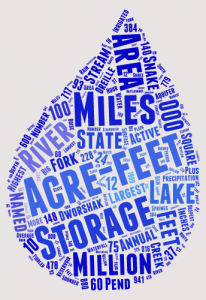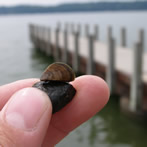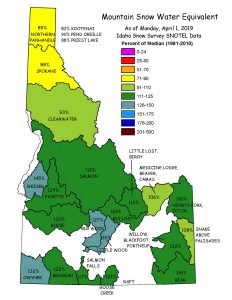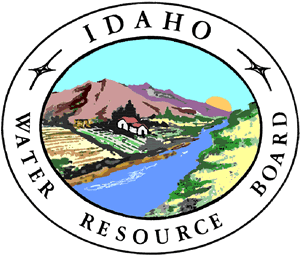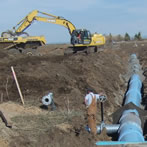A water right is authorization to use water in a prescribed manner, not to own the water itself. Without diversion and beneficial use, there is no water right.
To find existing water rights, new applications for water rights, new water right transfer applications, or statutory claims, visit the Water Rights Research page.
Listed below are terms frequently used in the water right process. For a complete list, visit the Terminology page.
A water right is the right to divert public waters and put them to a beneficial use in accordance with one’s priority date. See Idaho Code § 42-230.
Idaho’s constitution and statutes declare all waters of the state when flowing in their natural channels, including the waters of all natural springs and lakes within the boundaries of the state and groundwaters of the state, to be public waters. Idaho’s constitution and statutes also guarantee the right to appropriate those public waters. When a private right for the use of public waters is established by appropriation, a water right is established that is a real property right (much like property rights in land), and Idaho law protects real property rights. See Idaho Constitution Article XV and Idaho Code § 42 et al.
The priority date is the date when the water right was established and it determines who gets water when there is a shortage. If there is not enough water available to satisfy all of the water rights, then the oldest (or senior) water rights are satisfied first and so on (in order) until there is no water left. When there is not enough water to satisfy all the water rights, new (or junior) water rights holders do not get water.
Beneficial uses include domestic use, irrigation, stock-watering, manufacturing, mining, hydropower, municipal, aquaculture, recreation, as well as fish and wildlife. The amount of the water right is the amount of water put to beneficial use. Because of the beneficial use requirement, a water right (or a portion of a water right) might be lost if it is not used for a continuous five-year period.
A diversion is a structure used to divert the water from its natural source. Typical diversion structures include pumps, headgates, ditches, pipelines, and dams—or some combination. A diversion is generally required to establish a water right. The Idaho Water Resource Board is authorized to acquire water rights without diversions. These water rights are called “instream flow” water rights and are typically authorized for purposes of protecting some public interest in a natural stream or lake such as recreation, wildlife, or natural beauty. A water right may also be acquired to water livestock directly from the stream which is called an “instream livestock” water right.
Idaho water law is based on the appropriation doctrine because water rights in Idaho are based upon diversion and beneficial use of water. The appropriation doctrine has also been called “first in time is first in right” because the priority date determines who gets water when there is a shortage. A water right under Idaho law can be established only by appropriation, and once established, it can be lost if it is not used. See Idaho Code § 42-1502.
A domestic right is a right to the use of water for homes, organization camps, public campgrounds, livestock, and for any other purpose in connection with these uses including irrigation of up to one-half acre of land. See Idaho Code § 42-111.
An instream flow water right is a water right typically authorized for the purposes of protecting some public interest in a natural stream or lake such as recreation, wildlife, or natural beauty.
An instream livestock water right is a water right acquired to water livestock directly from the stream.
In some states, a land owner has the right to make “reasonable use” of groundwater beneath his or her land, or water naturally flowing on, through, or along the borders of his or her land. A riparian right to make use of that water is not limited by priority date and it cannot be lost by non-use. Idaho law does not recognize a “riparian right” to divert and use water. A water right under Idaho law can be established only by appropriation, and once established, it can be lost if it is not used.
Groundwater is water that is located beneath the ground surface in soil pore spaces and in the fractures of lithologic formations. A unit of rock or an unconsolidated deposit is called an aquifer when it can yield a usable quantity of water. Groundwater is recharged from, and eventually flows to, the surface naturally; natural discharge often occurs at springs and seeps, and can form oases or wetlands. Groundwater is also often withdrawn for agricultural, municipal, and industrial use by constructing and operating extraction wells. The study of the distribution and movement of groundwater is hydrogeology (or groundwater hydrology). See Idaho Code § 42-230.
Water collecting on the ground or in a stream, river, lake, wetland, or ocean is surface water, and is related to water collecting as groundwater or atmospheric water. Surface water is naturally replenished by precipitation and naturally lost through discharge to evaporation and subsurface seepage into the groundwater.
Additional Information
Water Rights Overview – Printable brochure about water rights in Idaho.
Water Use Information – Standards used by IDWR to evaluate water right applications and claims.
Water Supply Bank – Water rights holders who are not using all or a portion of their water rights in a given year can place their rights into the bank and make water available to others.
Statutes and Rules
Idaho Code § 42-201(2) – When a Water Right is Required
Idaho Code § 42-226 – Groundwaters are Public Waters
Idaho Code § 42-229 – Methods of Appropriation
IDAPA 37.01.01 – Rules of Procedure
IDAPA 37.03.02 – Beneficial Use Examination Rules
IDAPA 37.03.08 – Water Appropriation Rules
IDAPA 37.03.11 – Conjunctive Management Rules


